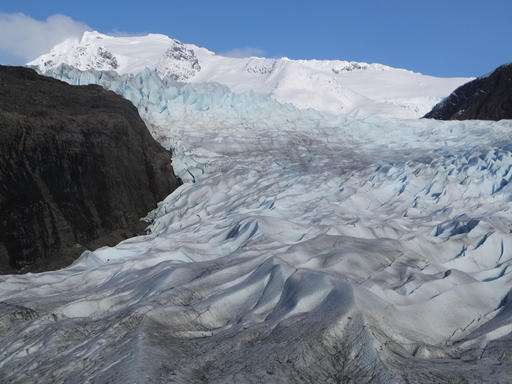Study: Juneau Ice Field to shrink if warming continues

A Rhode Island-size ice field in the mountains behind Alaska's capital could disappear by 2200 if climate-warming trends continue, according to a University of Alaska Fairbanks study.
The study published this week by the Journal of Glaciology predicts 60 percent of the ice in the Juneau Ice Field could be gone by 2099.
The Juneau Ice Field is the source for a major Alaska tourist attraction, the Mendenhall Glacier, visited last year by 450,000 people at a U.S. Forest Service center. By 2099, the study authors said, the glacier's ice will be harder to find.
"By the end of this century, people will most likely not be able to see the Mendenhall Glacier anymore from the visitor's center," said Regine Hock, a UAF glaciologist and one of the authors of the study.
The Juneau Ice Field, one of the largest ice fields in the Western Hemisphere, covers 1,500 square miles in the steep Coast Mountains, the range that lines Alaska's Panhandle and much of British Columbia.
The Mendenhall Glacier, a 13-mile river of ice, terminates about 10 miles north of downtown Juneau.
The paper's lead author, Florian Ziemen, of Hamburg, Germany, worked on the study during a year of post-doctoral work at the University of Alaska Fairbanks.
Modeling the melt of the ice field was challenging because of the lack of weather stations in the remote mountains. Lacking weather data, models make computations based on physical characteristics such as sunlight, clouds and their movement and precipitation, Ziemen said.
"It just grabs the physical system of the climate," he said.
The numbers are translated into grid points every 20 kilometers, which Ziemen had to adjust to account for Juneau's topography.
"The topography in the Juneau area is very steep," he said. "Just having one data point every 20 kilometers doesn't really resolve the mountain flanks and how the precipitation falls."
The researchers applied corrected climate data to a forecasting model and combined it with a glacier model developed by UAF researchers that has been used to make predictions for the Greenland Ice Sheet.
If warming trends continue, more than 60 percent of the ice will be lost by 2099, the paper predicts. All climate models predicted increased warming of the planet, Hock said.
"Even the lowest emission scenarios that are realistic predict a warming, essentially, all over the world," she said. "It's only the question, how aggressive?"
Ziemen picked a middle-of-the-road forecast, Hock said.
The high altitude of the Juneau Ice Field would make it less vulnerable to melting. If current climate continued, the ice field would shrink by 14 percent, Hock said.
More information: FLORIAN A. ZIEMEN et al. Modeling the evolution of the Juneau Icefield between 1971 and 2100 using the Parallel Ice Sheet Model (PISM), Journal of Glaciology (2016). dx.doi.org/10.1017/jog.2016.13
Journal information: Journal of Glaciology
© 2016 The Associated Press. All rights reserved.




















